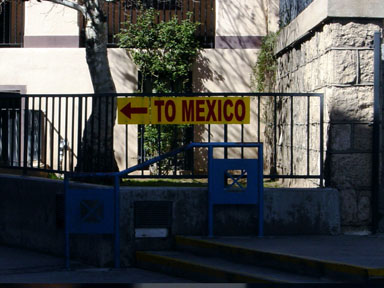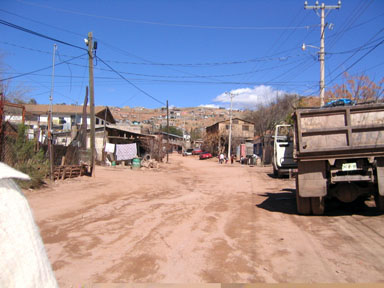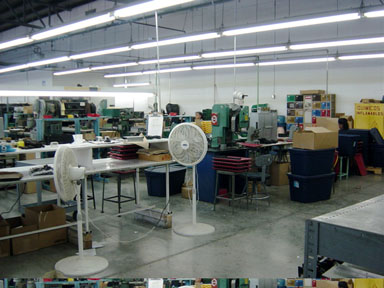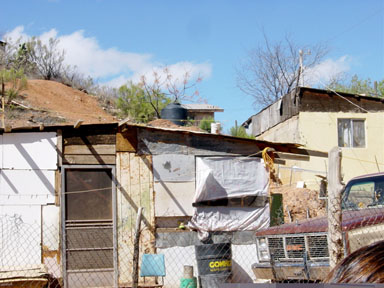
NOGALES TRIP: FEBRUARY 23, 2005

There was not much about our trip to Nogales that really impressed or stunned me. Most of what we heard or learned about, I have already learned about in various classes and books that I have read. I have not been to Mexico since I was three years old, so all the sights should have been new to me, yet they were not. Maybe they were not new to me because of the stories that I have heard from Mexican migrants, or the pictures I have seen on the news and in books, or from my Mexican relatives. The only thing that did strike me was when we first crossed the border and drove through “downtown”, was that I instantly felt like I was about six or seven years old. I knew the letters on the signs and on the shop windows, and some of the words I could make out, but for the most part, I felt like a child unable to read.
One of the
aspects of this trip that I did enjoy was lunch. In Tucson, when the
BorderLinks crew was briefing us on the schedule of our day, they
informed us that for lunch, we would be split up into groups, and have
lunch with families in Mexico. As soon as they said this, I was
dreading it! I felt very uncomfortable “imposing” on a Mexican family
to feed five to six strangers! However, when the van
 dropped
us off and Rosa came out of her house to greet us, the uneasy feeling
inside of me subsided. This ended up being my favorite part of the
entire trip! We only had one person in our group that new Spanish well
enough to translate; the rest of us enjoyed listening and picking out
the few words we recognized or that sounded familiar.
dropped
us off and Rosa came out of her house to greet us, the uneasy feeling
inside of me subsided. This ended up being my favorite part of the
entire trip! We only had one person in our group that new Spanish well
enough to translate; the rest of us enjoyed listening and picking out
the few words we recognized or that sounded familiar.
We were able to ask Rosa questions about her life in Mexico, about her family, about expenses, etc. She answered all of our questions openly and honestly and she asked questions of us as well. Despite all that we have learned this semester, all the stories about how horrible Mexican life is, and even some of the articles in the BorderLinks packet (Getting Across, by David Chorlton for example), Rosa and her family seemed truly happy. Rosa has eleven people, including her, living in their little home. One of her daughters is going to school, the other is married and has a family of her own, and the entire family is proud of both of them. We met three of her grandchildren who were running around the house the entire time, laughing and having fun. This aspect made me feel more at home and more comfortable in the environment as gatherings with my Mexican relatives are always hectic. Rosa nonverbally reiterated the fact that they are very bonded to their families and they put family higher than anything else. Rosa really made the trip for me. She was wonderful!
Another aspect
about the trip that made me think was the trip to the
Maquiladora. The
tour guide at Curtis de Mexico stated that they have more men working
for them than women. This aspect would not normally strike me as odd
except for the fact that I had just read the article in the BorderLinks
packet entitled We Are Not Machines: Corporations That Bring Jobs
Must Bring Justice Too by Maria Guadalupe Torres which states,
“usually, only women are hired in the maquiladoras creating conflicts
because the men cannot find work.”
 The
tour guide stated that right now, they are even short-staffed. She then
went on to inform us that their employees work a forty-eight hour
workweek and only get paid about thirty dollars a week. When someone
asked about protection for the workers, she stated that they are given
goggles and gloves, but most choose not to wear them. An excerpt in the
BorderLinks packet entitled Two Countries, One Population, Shared
Problems Community Health In The Borderlands: An Overview states,
“It is true the Mexico’s border states, due largely to employment
generated by the maquiladora industry, have poverty rates lower than the
national average.” This makes me wonder: if the maquiladoras would
raise their salary rates, how would the change affect Mexico’s border
states?
The
tour guide stated that right now, they are even short-staffed. She then
went on to inform us that their employees work a forty-eight hour
workweek and only get paid about thirty dollars a week. When someone
asked about protection for the workers, she stated that they are given
goggles and gloves, but most choose not to wear them. An excerpt in the
BorderLinks packet entitled Two Countries, One Population, Shared
Problems Community Health In The Borderlands: An Overview states,
“It is true the Mexico’s border states, due largely to employment
generated by the maquiladora industry, have poverty rates lower than the
national average.” This makes me wonder: if the maquiladoras would
raise their salary rates, how would the change affect Mexico’s border
states?

Overall, as stated before, the best part of the trip was learning about the Mexican culture and way of life from Rosa. The information obtained from all the other places that we visited, the Coalición de Derechos Humanos in Tucson, the U.S. Customs and Border Protection, the Casa de la Misericordia, and even the Maquiladora Curtis de Mexico, honestly could have been gathered in the classroom. I did find the views of some of the speakers at these locations intriguing, but even those could have been heard from a guest speaker. If I had to rate this trip on a scale of one to five with five being the best educational trip ever, I would give it a three.